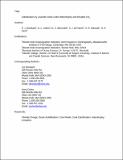Calcification by juvenile corals under heterotrophy and elevated CO[subscript 2]
Author(s)
Cohen, A. L.; McCorkle, D. C.; Putron, S. J.; Starczak, V. R.; Zicht, A. E.; Drenkard, Elizabeth Joan; ... Show more Show less
DownloadDrenkard final with tables and figures.pdf (652.1Kb)
PUBLISHER_POLICY
Publisher Policy
Article is made available in accordance with the publisher's policy and may be subject to US copyright law. Please refer to the publisher's site for terms of use.
Terms of use
Metadata
Show full item recordAbstract
Ocean acidification (OA) threatens the existence of coral reefs by slowing the rate of calcium carbonate (CaCO[subscript 3]) production of framework-building corals thus reducing the amount of CaCO3 the reef can produce to counteract natural dissolution. Some evidence exists to suggest that elevated levels of dissolved inorganic nutrients can reduce the impact of OA on coral calcification. Here, we investigated the potential for enhanced energetic status of juvenile corals, achieved via heterotrophic feeding, to modulate the negative impact of OA on calcification. Larvae of the common Atlantic golf ball coral, Favia fragum, were collected and reared for 3 weeks under ambient (421 μatm) or significantly elevated (1,311 μatm) CO[subscript 2] conditions. The metamorphosed, zooxanthellate spat were either fed brine shrimp (i.e., received nutrition from photosynthesis plus heterotrophy) or not fed (i.e., primarily autotrophic). Regardless of CO[subscript 2] condition, the skeletons of fed corals exhibited accelerated development of septal cycles and were larger than those of unfed corals. At each CO[subscript 2] level, fed corals accreted more CaCO[subscript 3] than unfed corals, and fed corals reared under 1,311 μatm CO[subscript 2] accreted as much CaCO[subscript 3] as unfed corals reared under ambient CO[subscript 2]. However, feeding did not alter the sensitivity of calcification to increased CO[subscript 2]; ∆ calcification/∆Ω was comparable for fed and unfed corals. Our results suggest that calcification rates of nutritionally replete juvenile corals will decline as OA intensifies over the course of this century. Critically, however, such corals could maintain higher rates of skeletal growth and CaCO[subscript 3] production under OA than those in nutritionally limited environments.
Date issued
2013-03Department
Massachusetts Institute of Technology. Department of Earth, Atmospheric, and Planetary Sciences; Woods Hole Oceanographic InstitutionJournal
Coral Reefs
Publisher
Springer-Verlag
Citation
Drenkard, E. J., A. L. Cohen, D. C. McCorkle, S. J. Putron, V. R. Starczak, and A. E. Zicht. “Calcification by Juvenile Corals Under Heterotrophy and Elevated CO2.” Coral Reefs 32, no. 3 (September 2013): 727–735.
Version: Author's final manuscript
ISSN
0722-4028
1432-0975